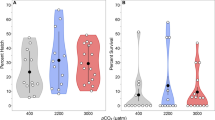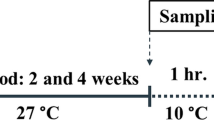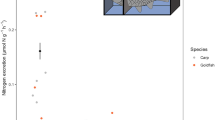Abstract
This study investigated the effects of long-term heat exposure on Japanese flounder (Paralichthys olivaceus) and its hybrids (P. olivaceus ♀ × summer flounder Paralichthys dentatus ♂). From 24 ± 0.5 °C, temperature was increased by 1 ± 0.5 °C in a day and was kept at that temperature for 5 days before next rise. Cumulative survival rate (CSR), cumulative survival rate under different temperature (CSR-T), histological alteration, and related enzyme activities were investigated. In P. olivaceus, mass mortality occurred at 29 and 32 °C (the CSR-T dropped to 42.39 %), and serious gill damages appeared at 30 and 32 °C. Meanwhile, the activities of superoxide dismutase (SOD), catalase (CAT), lysozyme (LZM), and pyruvate kinase (PK) declined around 29 and 32 °C (except for CAT). In comparison with P. olivaceus, the CSR of the hybrids was higher, the gill kept a better structural integrity, and the activities of SOD, CAT, LZM, and PK showed tiny fluctuations. The results suggested that during the process of chronic heat stress, P. olivaceus seemed to be more sensitive to 29 and 32 °C, and the manifestations in survival, histology, and enzyme activity were generally consistent. For the hybrids, the comparatively insensitivity to high temperature might imply its better heat tolerance.




Similar content being viewed by others

References
Abel P, Skidmore J (1975) Toxic effects of an anionic detergent on the gills of rainbow trout. Water Res 9(8):759–765
Abele D (2002) Toxic oxygen: the radical life-giver. Nature 420(6911):27
Abele D, Puntarulo S (2004) Formation of reactive species and induction of antioxidant defence systems in polar and temperate marine invertebrates and fish. Comp Biochem Phys A 138(4):405–415
Adamo SA (2004) How should behavioural ecologists interpret measurements of immunity? Anim Behav 68(6):1443–1449
Ahmad SM, Shah FA, Bhat FA, Bhat JIA, Balkhi MH (2011) Thermal adaptability and disease association in common carp (Cyprinus carpio communis) acclimated to different (four) temperatures. J Therm Biol 36(8):492–497
Apel K, Hirt H (2004) Reactive oxygen species: metabolism, oxidative stress, and signal transduction. Annu Rev Plant Biol 55:373–399
Beitinger TL, Bennett WA (2000) Quantification of the role of acclimation temperature in temperature tolerance of fishes. Environ Biol Fish 58(3):277–288
Beitinger TL, Bennett WA, McCauley RW (2000) Temperature tolerances of North American freshwater fishes exposed to dynamic changes in temperature. Environ Biol Fish 58(3):237–275
Bengtson D (1999) Aquaculture of summer flounder (Paralichthys dentatus): status of knowledge, current research and future research priorities. Aquaculture 176(1):39–49
Benville PE Jr, Smith CE, Shanks WE (1968) Some toxic effects of dimethyl sulfoxide in salmon and trout. Toxicol Appl Pharmacol 12(2):156–178
Boughammoura S, Kessabi K, Chouchene L, Messaoudi I (2013) Effects of cadmium and high temperature on some parameters of calcium metabolism in the killifish (Aphanius fasciatus). Biol Trace Elem Res 154(1):73–80
Cadenas E (1989) Biochemistry of oxygen toxicity. Annu Rev Biochem 58(1):79–110
Castro C, Perez-Jimenez A, Guerreiro I, Peres H, Castro-Cunha M, Oliva-Teles A (2012) Effects of temperature and dietary protein level on hepatic oxidative status of Senegalese sole juveniles (Solea senegalensis). Comp Biochem Phys A 163(3–4):372–378
Chung K (2001) Critical thermal maxima and acclimation rate of the tropical guppy Poecilla reticulata. Hydrobiologia 462(1–3):253–257
Crockett EL (2008) The cold but not hard fats in ectotherms: consequences of lipid restructuring on susceptibility of biological membranes to peroxidation, a review. J Comp Physiol B 178(7):795–809
Currie RJ, Bennett WA, Beitinger TL, Cherry DS (2004) Upper and lower temperature tolerances of juvenile freshwater game-fish species exposed to 32 days of cycling temperatures. Hydrobiologia 523(1–3):127–136
Currie S, Ahmady E, Watters MA, Perry SF, Gilmour KM (2013) Fish in hot water: hypoxaemia does not trigger catecholamine mobilization during heat shock in rainbow trout (Oncorhynchus mykiss). Comp Biochem Phys A 165(2):281–287
Dalela R, Bhatnagar M, Tyagi A, Verma S (1979) Histological damage of gills in Channa gachua after acute and subacute exposure to endosulfan and rogor. Mikroskopie 35(11–12):301
Dalvi RS, Pal AK, Tiwari LR, Baruah K (2012) Influence of acclimation temperature on the induction of heat-shock protein 70 in the catfish Horabagrus brachysoma (Gunther). Fish Physiol Biochem 38(4):919–927
Das UN (2006) Pyruvate is an endogenous anti-inflammatory and anti-oxidant molecule. Med Sci Monit 12(5):RA79
Dash G, Yonzone P, Chanda M, Paul M (2011) Histopathological changes in Labeo rohita (Hamilton) fingerlings to various acclimation temperatures. Chron Young Sci 2(1):29–36
Dent L, Lutterschmidt WI (2003) Comparative thermal physiology of two sympatric sunfishes (Centrarchidae: Perciformes) with a discussion of microhabitat utilization. J Therm Biol 28(1):67–74
Du H, Zhou P, Huang B (2013) Antioxidant enzymatic activities and gene expression associated with heat tolerance in a cool-season perennial grass species. Environ Exp Bot 87:159–166
Eller LL (1975) Gill lesions in freshwater teleosts. The pathology of fishes. Univ of Wisconsin Press, Madison, WI
Fang S (2013) Pathogenicity of two vibrio strains in South China Sea to Haliotis discus hannai Ino. University of Chinese Academy of Sciences (Institute of Oceanology), Tsingtao
Flores-Lopes F, Thomaz AT (2011) Histopathologic alterations observed in fish gills as a tool in environmental monitoring. Braz J Biol 71(1):179–188
Ford T, Beitinger TL (2005) Temperature tolerance in the goldfish, Carassius auratus. J Therm Biol 30(2):147–152
Fridovich I (1998) Oxygen toxicity: a radical explanation. J Exp Biol 201(8):1203–1209
Fry FEJ (1947) Effects of the environment on animal activity. Studies in biology, series. University of Toronto Press, Toronto
Gardner G (1975) Chemically induced lesions in estuarine or marine teleosts. In: Ribelin W, Migaki G (eds) The pathology of fishes. University of Wisconsin Press, Madison, WI, pp 657–694
Haensly W, Neff J, Sharp J, Morris A, Bedgood M, Boem P (1982) Histopathology of Pleuronectes platessa L. from Aber Wrac’h and Aber Benoit, Brittany, France: long-term effects of the Amoco Cadiz crude oil spill. J Fish Dis 5(5):365–391
Halliwell B, Gutteridge JM (1999) Free radicals in biology and medicine, vol 135. Oxford university press Oxford, Oxford
Heath N (1884) Effect of cold on fishes. Bull US Fish Comm 4:369–371
Hochachka PW, Somero GN (2002) Biochemical adaptation: mechanism and process in physiological evolution, vol 480. Oxford University Press on Demand, New York
Hughes GM (1966) The dimensions of fish gills in relation to their function. J Exp Biol 45(1):177–195
Hutchison VH (1976) Factors influencing thermal tolerances of individual organisms. In: Proceedings of a symposium on thermal ecology II, Oak Ridge, Tennessee, 1975. Georgia, pp 10–26
Jacobs D, Esmond EF, Melisky EL, Hocutt CH (1981) Morphological changes in gill epithelia of heat-stressed rainbow trout, Salmo gairdneri: evidence in support of a temperature-induced surface area change hypothesis. Can J Fish Aquat Sci 38(1):16–22
Jian CY, Cheng SY, Chen JC (2003) Temperature and salinity tolerances of yellowfin sea bream, Acanthopagrus latus, at different salinity and temperature levels. Aquac Res 34(2):175–185
Kerfoot JR (2012) Thermal tolerance of the invasive Belonesox belizanus, pike killifish, throughout ontogeny. J Exp Zool A Ecol Genet Physiol 317A(5):266–274
Kondo H, Suda S, Kawana Y, Hirono I, Nagasaka R, Kaneko G, Ushio H, Watabe S (2012) Effects of feed restriction on the expression profiles of the glucose and fatty acid metabolism-related genes in rainbow trout Oncorhynchus mykiss muscle. Fish Sci 78(6):1205–1211
Kumar S, Sahu NP, Pal AK, Subramanian S, Priyadarshi H, Kumar V (2011) High dietary protein combats the stress of Labeo rohita fingerlings exposed to heat shock. Fish Physiol Biochem 37(4):1005–1019
Lencioni V, Bernabò P, Cesari M, Rebecchi L (2013) Thermal stress induces HSP70 proteins synthesis in larvae of the cold stream non-biting midge Diamesa cinerella Meigen. Arch Insect Biochem 83(1):1–14
Lesser MP (2006) Oxidative stress in marine environments: biochemistry and physiological ecology. Annu Rev Physiol 68:253–278
López-Olmeda J, Sánchez-Vázquez F (2011) Thermal biology of zebrafish (Danio rerio). J Therm Biol 36(2):91–104
Lushchak VI, Bagnyukova TV (2006) Temperature increase results in oxidative stress in goldfish tissues. 2. Antioxidant and associated enzymes. Comp Biochem Phys C 143(1):36–41
Lutterschmidt WI, Hutchison VH (1997a) The critical thermal maximum: history and critique. Can J Zool 75(10):1561–1574
Lutterschmidt WI, Hutchison VH (1997b) The critical thermal maximum: data to support the onset of spasms as the definitive end point. Can J Zool 75(10):1553–1560
Madeira D, Narciso L, Cabral HN, Vinagre C, Diniz MS (2013) Influence of temperature in thermal and oxidative stress responses in estuarine fish. Comp Biochem Phys A 166(2):237–243
Mallatt J (1985) Fish gill structural changes induced by toxicants and other irritants: a statistical review. Can J Fish Aquat Sci 42(4):630–648
Martinez-Alvarez RM, Morales AE, Sanz A (2005) Antioxidant defenses in fish: biotic and abiotic factors. Rev Fish Biol Fisher 15(1–2):75–88
Mitchell A, Grizzle JM, Plumb JA (1978) Nifurpirinol (Furanace; P-7138) related lesions on channel catfish Ictalurus punctatus (Rafinesque). J Fish Dis 1(1):115–121
Mittler R (2002) Oxidative stress, antioxidants and stress tolerance. Trends Plant Sci 7(9):405–410
Mora C, Maya MF (2006) Effect of the rate of temperature increase of the dynamic method on the heat tolerance of fishes. J Therm Biol 31(4):337–341
Mora C, Ospina A (2001) Tolerance to high temperatures and potential impact of sea warming on reef fishes of Gorgona Island (tropical eastern Pacific). Mar Biol 139(4):765–769
Nascimento AA, Araujo FG, Gomes ID, Mendes RMM, Sales A (2012) Fish gills alterations as potential biomarkers of environmental quality in a eutrophized tropical river in south-eastern Brazil. Anat Histol Embryol 41(3):209–216
Newstead JD (1967) Fine structure of the respiratory lamellae of teleostean gills. Zeitschrift für Zellforschung und Mikroskopische Anatomie 79(3):396–428
Packer DB, Griesbach SJ, Berrien PL, Zetlin CA, Johnson DL, Morse WW (1999) Essential fish habitat source document: summer flounder, Paralichthys dentatus, life history and habitat characteristics. NOAA Tech Memo NMFS-NE-151
Parihar MS, Javeri T, Hemnani T, Dubey AK, Prakash P (1997) Responses of superoxide dismutase, glutathione peroxidase and reduced glutathione antioxidant defenses in gills of the freshwater catfish (Heteropneustes fossilis) to short-term elevated temperature. J Therm Biol 22(2):151–156
Pauley GB, Nakatani RE (1967) Histopathology of “gas-bubble” disease in salmon fingerlings. J Fish Board Can 24(4):867–871
Poleksic V, Mitrovic-Tutundzic V (1994) Fish gills as a monitor of sublethal and chronic effects of pollution. Sublethal and chronic effects of pollutants on freshwater fish. Fishing News Books, Oxford
Pörtner H (2001) Climate change and temperature-dependent biogeography: oxygen limitation of thermal tolerance in animals. Naturwissenschaften 88(4):137–146
Rady AA (1993) Effect of change in environmental temperature on antioxidant enzyme activities and lipid peroxidation in red blood cells of carp. Comp Biochem Phys B 104(4):695–698
Rajaguru S, Ramachandran S (2001) Temperature tolerance of some estuarine fishes. J Therm Biol 26(1):41–45
Reis AB, Sant’Ana DDG, de Azevedo JF, Merlini LS, Araujo EJD (2009) The influence of the aquatic environment in tanks sequentially interconnected with PVC pipes on the gill epithelium and lamellas of tilapia (Oreochromis niloticus). Pesqui Vet Bras 29(4):303–311
Ribelin WE (1975) The pathology of fishes: proceedings of a symposium. University of Wisconsin Press, Madison, WI
Rojas LM, Mata C, Oliveros A, Salazar-Lugo R (2013) Histology of gill, liver and kidney in juvenile fish Colossoma macropomum exposed to three temperatures. Rev Biol Trop 61(2):797–806
Rombough P, Garside E (1977) Hypoxial death inferred from thermally induced injuries at upper lethal temperatures, in the banded killifish, Fundulus diaphanus (LeSueur). Can J Zool 55(10):1705–1719
Salazar-Lugo R, Mata C, Oliveros A, Rojas LM, Lemus M, Rojas-Villarroel E (2011) Histopathological changes in gill, liver and kidney of neotropical fish Colossoma macropomum exposed to paraquat at different temperatures. Environ Toxicol Pharmacol 31(3):490–495
Saravana Bhavan P, Geraldine P (2000) Histopathology of the hepatopancreas and gills of the prawn Macrobrachium malcolmsonii exposed to endosulfan. Aquat Toxicol 50(4):331–339
Scott A, Rogers W (1980) Histological effects of prolonged sublethal hypoxia on channel catfish Ictalurus punctatus (Rafinesque). J Fish Dis 3(4):305–316
Sheng L, Xu J, Wang Y, Liu X, Yu W, Li W (2005) Effects of heat shock on the GPT, CAT and ultrastructure of common carp. J Toxicol 19(A03):302–303
Shrimpton JM, Zydlewski JD, Heath JW (2007) Effect of daily oscillation in temperature and increased suspended sediment on growth and molting in juvenile chinook salmon, Oncorhynchus tshawytscha. Aquaculture 273(2–3):269–276
Smart G (1976) The effect of ammonia exposure on gill structure of the rainbow trout (Salmo gairdneri). J Fish Biol 8(6):471–475
Smirnoff N (1993) The role of active oxygen in the response of plants to water deficit and desiccation. New Phytol 125:27–58
Storey KB (1996) Oxidative stress: animal adaptations in nature. Braz J Med Biol Res 29:1715–1733
Sui J, Ma D, Liu Q, Xu S, Xiao Z, Lin F, Xiao Y, Li J (2012) Germ cells and fertilization differences among Japanese flounder Paralichthys olivaceus, summer flounder Paralichthys dentatus and their first and second generations. J Fish Biol 80(3):473–485
Sui J, Liu Q, Xiao Z, Ma D, Xu S, He T, Liu Y, Xiao Y, Li J (2013) The viability, melanophore and embryo genesis of first-and second-generation hybrids between Paralichthys olivaceus and P. dentatus. Mar Biol Res 9(2):220–226
Thophon S, Kruatrachue M, Upatham ES, Pokethitiyook P, Sahaphong S, Jaritkhuan S (2003) Histopathological alterations of white seabass, Lates calcarifer, in acute and subchronic cadmium exposure. Environ Pollut 121(3):307–320
Tomanek L (2010) The role of oxidative stress in setting thermal tolerance limits in Mytilus. Comp Biochem Phys A 157(1):S43
Wang H (2005) Effects of thermal shock on the activities of four kinds of enzyme in Carasslus auratus. Northeast Normal University, Changchun
Wang Z, Pote J, Huang B (2003) Responses of cytokinins, antioxidant enzymes, and lipid peroxidation in shoots of creeping bentgrass to high root-zone temperatures. J Am Soc Hortic Sci 128(5):648–655
Wang X, Wang L, Zhang H, Ji Q, Song L, Qiu L, Zhou Z, Wang M, Wang L (2012) Immune response and energy metabolism of Chlamys farreri under Vibrio anguillarum challenge and high temperature exposure. Fish Shellfish Immun 33(4):1016–1026
Wedemeyer GA, Meyer FP, Smith L (1976) Environmental stress and fish diseases. TFH Publications Inc, Neptune City, NJ
Wells MM (1914) Resistance and reactions of fishes to temperature. Trans Illinois Acad Sci 7:48–59
Werner I, Viant M, Rosenblum E, Gantner A, Tjeerdema R, Johnson M (2006) Cellular responses to temperature stress in steelhead trout (Onchorynchus mykiss) parr with different rearing histories. Fish Physiol Biochem 32(3):261–273
Wood EM (1960) Definitive diagnosis of fish mortalities. J Water Pollut Control Fed 32(9):994–999
Yang R, Xie C, Fan Q, Gao C, Fang L (2010) Ontogeny of the digestive tract in yellow catfish Pelteobagrus fulvidraco larvae. Aquaculture 302(1):112–123
Zhang Z, Jia G, Zuo J, Zhang Y, Lei J, Ren L, Feng D (2012) Effects of constant and cyclic heat stress on muscle metabolism and meat quality of broiler breast fillet and thigh meat. Poult Sci 91(11):2931–2937
Zhao H (2011) Fundamental research on the molecular mechanism in response to heat stress in Apostichopus japonicus (Selenka). Dissertation, University of Chinese Academy of Sciences (Institute of Oceanology), Tsingtao, Shandong
Acknowledgments
The authors are grateful to Professor Xiao Liu and Professor Ying Liu in Institute of Oceanology, Chinese Academy of Sciences, for kindly providing circulating water systems. This research was supported by Modern Agro-industry Technology Research System (nycytx-50), the Innovation Key Program of the Chinese Academy of Sciences and the Experiment and Demonstration of Scientific and Technical Innovation on Modern Ecological Ocean Agriculture (KSC2-EW-B-3), Science-Technology R&D project of Shandong Province (2011GHy11530), Jiangsu Provincial Natural Science Foundation of China (BK2012222), and Fundamental Research Project of Technology Program of Qingdao, China (12-1-4-8(6)-jch, 12-1-4-8-(7)-jch, and 12-4-1-51-hy).
Author information
Authors and Affiliations
Corresponding authors
Rights and permissions
About this article
Cite this article
Liu, Y., Ma, D., Zhao, C. et al. Histological and enzymatic responses of Japanese flounder (Paralichthys olivaceus) and its hybrids (P. olivaceus ♀ × P. dentatus ♂) to chronic heat stress. Fish Physiol Biochem 40, 1031–1041 (2014). https://doi.org/10.1007/s10695-013-9903-6
Received:
Accepted:
Published:
Issue Date:
DOI: https://doi.org/10.1007/s10695-013-9903-6



